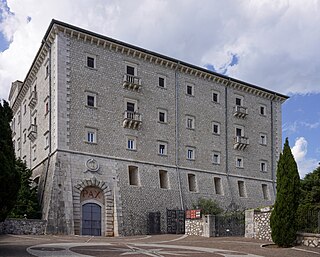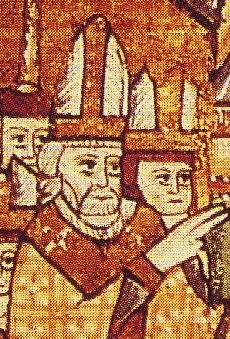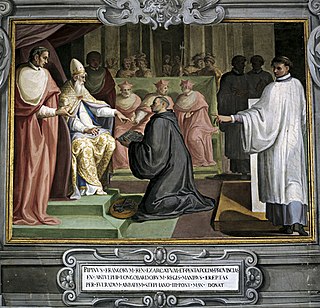Pope Marinus I was the bishop of Rome and ruler of the Papal States from 882 until his death. Controversially at the time, he was already a bishop when he became pope, and had served as papal legate to Constantinople. He was also erroneously called Martin II leading to the second pope named Martin to take the name Martin IV.
Pope Benedict VI was the bishop of Rome and ruler of the Papal States from 19 January 973 to his death in 974. His brief pontificate occurred in the political context of the establishment of the Holy Roman Empire, during the transition between the reigns of Otto I and Otto II, incorporating the struggle for power of Roman aristocratic families such as the Crescentii.
Pope Boniface VI was the bishop of Rome and ruler of the Papal States in April 896. He was a native of Rome. His election came about as a result of riots soon after the death of Pope Formosus. Prior to his reign, he had twice incurred a sentence of deprivation of orders as a subdeacon and as a priest. After a pontificate of fifteen days, he is said by some to have died of the gout, by others to have been forcibly ejected to make way for Stephen VI, the candidate of the Spoletan party.
Pope Gregory II was the bishop of Rome from 19 May 715 to his death. His defiance of Emperor Leo III the Isaurian as a result of the iconoclastic controversy in the Eastern Empire prepared the way for a long series of revolts, schisms, and civil wars that eventually led to the establishment of the temporal power of the popes.
Pope Sergius II was the bishop of Rome and ruler of the Papal States from January 844 to his death in 847. Sergius II's pontificate saw the Arab raid against Rome as well as the city's redevelopment.

Pope Zachary was the bishop of Rome from 28 November 741 to his death. He was the last pope of the Byzantine Papacy. Zachary built the original church of Santa Maria sopra Minerva, forbade the traffic of slaves in Rome, negotiated peace with the Lombards, and sanctioned Pepin the Short's usurpation of the Frankish throne from Childeric III. Zachary is regarded as a capable administrator and a skillful and subtle diplomat in a dangerous time.

Pope Victor III, was the head of the Catholic Church and ruler of the Papal States from 24 May 1086 to his death. He was the successor of Pope Gregory VII, yet his pontificate is far less notable than his time as Desiderius, the great abbot of Montecassino.

Monte Cassino is a rocky hill about 130 kilometres (80 mi) southeast of Rome, in the Latin Valley, Italy, 2 kilometres west of Cassino and at an elevation of 520 m (1,710 ft). Site of the Roman town of Casinum, it is widely known for its abbey, the first house of the Benedictine Order, having been established by Benedict of Nursia himself around 529. It was for the community of Monte Cassino that the Rule of Saint Benedict was composed.
Pope Evaristus was the bishop of Rome from c. 99 to his death c. 107. He was also known as Aristus and is venerated as a saint in the Eastern Orthodox Church, the Catholic Church, and Oriental Orthodoxy. It is likely that John the Apostle died during his reign period, marking the end of the Apostolic Age.
Pope Pelagius II was the bishop of Rome from 26 November 579 to his death.
Pope John XIX, born Romanus, was the bishop of Rome and ruler of the Papal States from 1024 to his death. He belonged to the family of the powerful counts of Tusculum, succeeding his brother, Benedict VIII. Papal relations with the Patriarchate of Constantinople soured during John XIX's pontificate. He was a supporter of Emperor Conrad II and patron of the musician Guido of Arezzo.
Pope John VI was the bishop of Rome from 30 October 701 to his death. John VI was a Greek from Ephesus who reigned during the Byzantine Papacy. His papacy was noted for military and political breakthroughs on the Italian Peninsula. He was succeeded by Pope John VII after a vacancy of less than two months. The body of the pope was buried in Old St. Peter's Basilica.
Pope John XVIII was the bishop of Rome and nominal ruler of the Papal States from January 1004 to his abdication in July 1009. He wielded little temporal power, ruling during the struggle between John Crescentius and Emperor Henry II for the control of Rome.

A Papal Mass is the Solemn Pontifical High Mass celebrated by the Pope. It is celebrated on such occasions as a papal coronation, an ex cathedra pronouncement, the canonization of a saint, on Easter or Christmas or other major feast days.

Papal inauguration is a liturgical service of the Catholic Church within Mass celebrated in the Roman Rite but with elements of Byzantine Rite for the ecclesiastical investiture of a pope. Since the inauguration of Pope John Paul I, it has not included the 820-year-old (1143–1963) papal coronation ceremony.

Bobbio Abbey is a monastery founded by Irish Saint Columbanus in 614, around which later grew up the town of Bobbio, in the province of Piacenza, Emilia-Romagna, Italy. It is dedicated to Saint Columbanus. It was famous as a centre of resistance to Arianism and as one of the greatest libraries in the Middle Ages. The abbey was dissolved under the French administration in 1803, although many of the buildings remain in other uses.

The 1088 papal election subsequent to the death of Pope Victor III in 1087 was held on 12 March 1088. Six cardinal-bishops, assisted by two lower-ranking cardinals, elected Cardinal-Bishop of Ostia Odon de Lagery as the new Pope. He assumed the name Urban II.

From 756 to 857, the papacy shifted from the influence of the Byzantine Empire to that of the kings of the Franks. Pepin the Short, Charlemagne, and Louis the Pious had considerable influence in the selection and administration of popes. The "Donation of Pepin" (756) ratified a new period of papal rule in central Italy, which became known as the Papal States.

The 1099 papal election following the death of Pope Urban II took place on 13 August 1099. Before his death, Urban had designated Cardinal Rainerius da Bieda as his successor. The cardinal-electors, with the consent of the lower Roman clergy, chose Rainerius, who, after a flight and over his considerable objections, accepted and took the name Paschal II. He was consecrated a bishop and crowned pope on the next day.

The 1086 papal election ended with the election of Desiderius, abbot of Monte Cassino as Pope Gregory VII's successor after a year-long period of sede vacante.








